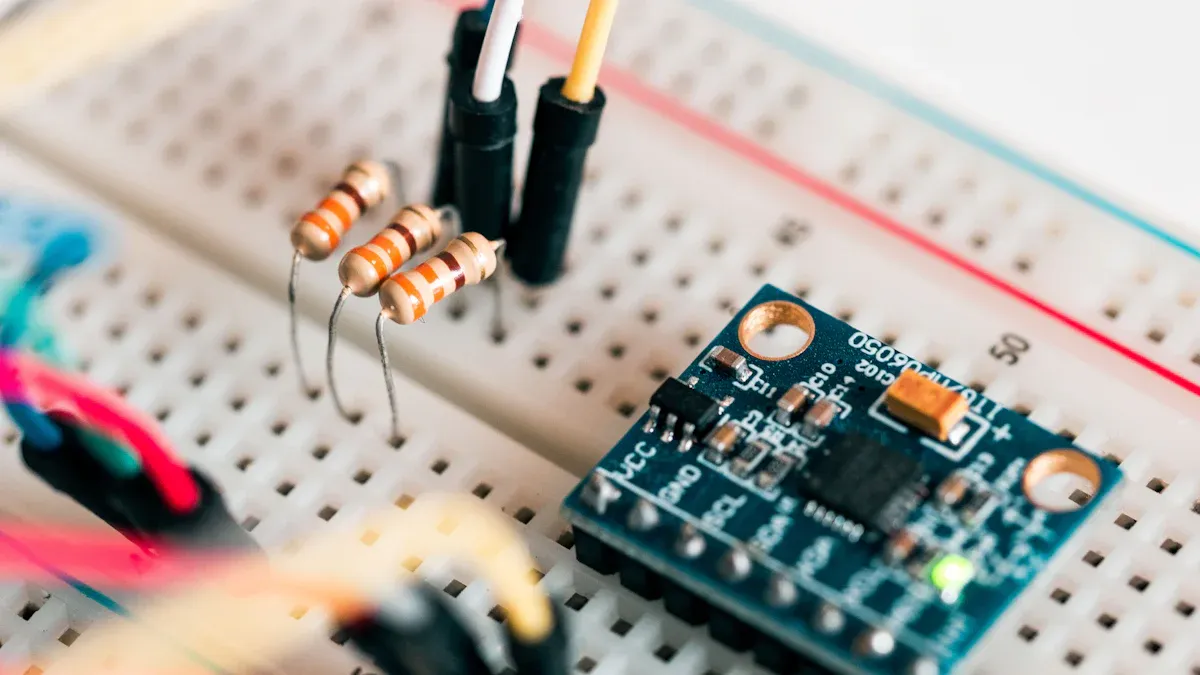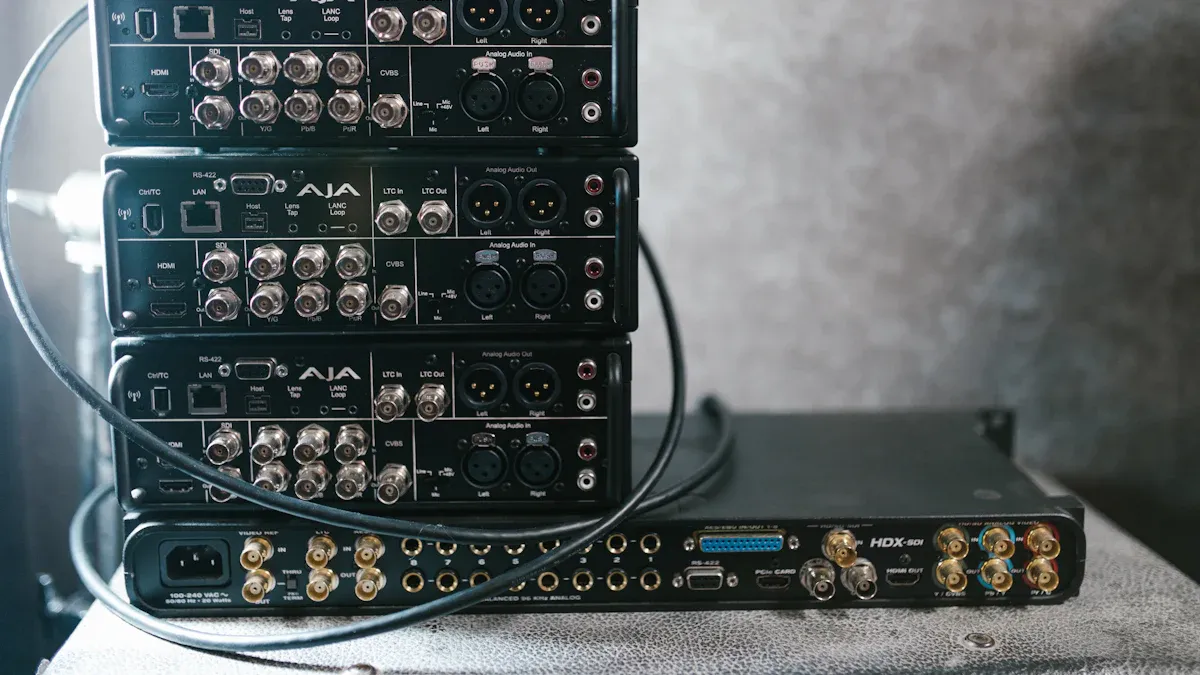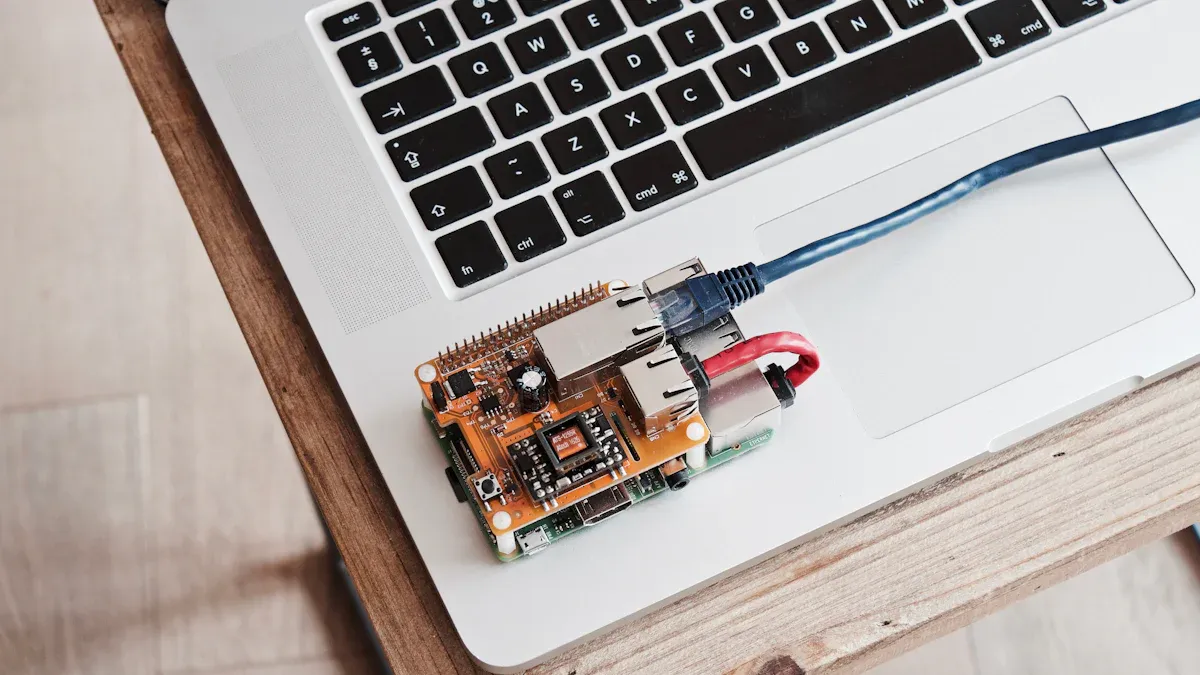What is an audio diff line rcvr chip and how does it work

An AUDIO DIFF LINE RCVR chip helps you get clearer sound by picking up audio signals and blocking unwanted noise. You often find this chip in professional audio gear because it improves signal clarity, even in noisy places. Look at the table below to see how these chips keep your music or voice clean:
Performance Metric | Typical Value or Description |
|---|---|
Common-Mode Rejection (CMR) | |
Input Impedance | Around 25 kΩ; up to megohms with FET buffers |
Total Harmonic Distortion + Noise | Low at normal levels; rises at very high input |
Dynamic Range |
Key Takeaways
Audio differential line receiver chips block noise and keep sound clear by comparing two signals and canceling out unwanted interference.
These chips use differential signaling, sending audio over two wires with opposite signals to protect sound quality even over long cables.
They offer low distortion and wide frequency range, making music and voice sound natural and detailed in noisy environments.
Using balanced cables with these chips improves noise rejection and ensures the best audio performance.
These chips are widely used in professional audio, cars, factories, and medical devices to deliver reliable, high-quality sound.
AUDIO DIFF LINE RCVR Chip Basics

What It Is
An AUDIO DIFF LINE RCVR chip is a small electronic part that helps you get clean audio signals from cables. You often see this chip in sound systems, recording studios, and even in some home audio gear. It works by taking in two versions of the same audio signal—one positive and one negative. This setup is called "differential" because the chip looks at the difference between the two signals.
When you use an AUDIO DIFF LINE RCVR chip, you can send audio over long cables without picking up much noise. This chip is different from regular receiver chips because it focuses on blocking unwanted signals, like hums or buzzes, that can sneak into your audio lines.
You can compare the performance of these chips to other types by looking at some key numbers. Here is a table that shows how two popular audio differential line receiver chips perform:
Parameter | THAT 1240 Series | THAT 1280 Series | Unit |
|---|---|---|---|
Common Mode Rejection Ratio (CMRR) | 90 dB at 60 Hz, 85 dB at 20 kHz | dB | |
Total Harmonic Distortion (THD) | 0.0006 % | 0.0006 % | % |
Output Noise (BW = 20 kHz) | -106 dBu | -107.3 dBu | dBu |
Bandwidth | > 8.6 MHz | > 7.6 MHz | MHz |
Slew Rate | 12 V/µs | 15 V/µs | V/µs |
Current Consumption | 2 mA | 3 mA | mA |
These numbers show that an AUDIO DIFF LINE RCVR chip can block a lot of noise (high CMRR), keep distortion very low, and work with a wide range of audio signals.
Core Function
The main job of an AUDIO DIFF LINE RCVR chip is to make sure your audio stays clear, even if you use long cables or work in a noisy place. The chip does this by comparing the two input signals. If both signals pick up the same noise, the chip cancels it out. Only the real audio signal gets through.
You get several benefits from this design:
Noise Rejection: The chip removes unwanted signals that both wires pick up, like electrical hum from lights or power cables.
Low Distortion: Precision-matched resistors inside the chip help keep your music or voice sounding natural.
Wide Bandwidth: You can use these chips for both low and high-frequency sounds without losing quality.
Note: Integrated audio differential line receivers, like the ones in the table above, use special resistor matching and circuit tricks to block noise better than most regular op-amps or transformer-based solutions. They also use less space and cost less than bulky transformers.
Some chips, such as those in the THAT 1200 series, use patented designs to boost performance. They can handle small differences in cable quality or length, which helps keep your audio clean in real-world setups. You can find more details about how these chips work in technical articles and product overviews from companies like Texas Instruments.
When you choose an AUDIO DIFF LINE RCVR chip, you get a balance of strong noise rejection, low distortion, and reliable sound. This makes them a top choice for anyone who wants the best audio quality in tough environments.
How It Works

Differential Signaling
When you use an AUDIO DIFF LINE RCVR chip, you send your audio signal down two wires instead of one. One wire carries the normal signal, and the other carries the same signal but flipped upside down. This setup is called differential signaling. The chip looks at both wires and measures the difference between them. If the voltage on one wire goes up, the voltage on the other goes down by the same amount.
Differential amplifiers inside the chip boost the difference between these two signals. They ignore anything that is the same on both wires, like noise or interference. This method helps your audio stay clear, even if you run cables over long distances or near other electronics.
Differential signaling also protects your audio from ground problems. The chip only cares about the difference between the two wires, so it does not matter if the ground level changes along the cable. This feature is very helpful when you connect equipment that sits far apart.
You can see this approach in many high-quality audio systems. Engineers use differential signaling to keep signals strong and clean, even when digital and analog parts sit close together. Careful design, like matching the length of the wires and keeping them close together, makes the noise rejection even better.
Noise Rejection
Noise can sneak into your audio cables from lights, motors, or other electronics. The AUDIO DIFF LINE RCVR chip fights this problem by rejecting common-mode noise. When both wires pick up the same unwanted signal, the chip cancels it out. Only the real audio signal gets through.
Lab tests show how well this works. Engineers measure something called Common-Mode Rejection Ratio (CMRR). This number tells you how much noise the chip can block. Some chips can block noise as low as -125 dB between 10 Hz and 1 MHz. That means you hear almost no hum or buzz, even in tough environments.
If the wires or parts inside the chip do not match perfectly, the noise rejection drops. For example, if one wire has a little more resistance than the other, the chip might only block noise down to 60 dB. Careful design and good parts help keep the noise rejection high.
Here are some ways engineers boost noise rejection:
Use tightly matched wires and parts.
Keep the two wires close together.
Add shielding or guard traces on the circuit board.
Tip: If you want the best noise rejection, always use balanced cables and connect them to a good AUDIO DIFF LINE RCVR chip.
Signal Conversion
After the chip cancels out the noise, it needs to turn the two-wire signal into something your speakers or audio gear can use. This process is called signal conversion. The AUDIO DIFF LINE RCVR chip takes the difference between the two input signals and creates a single output. This output is called a single-ended signal.
You can connect this single-ended output to mixers, amplifiers, or recording devices. The conversion keeps your audio strong and clear. It also lets you use standard audio equipment that expects a single wire for the signal.
The signal conversion process works like this:
The chip receives the two balanced signals.
It subtracts one from the other, removing any noise that both picked up.
It sends out a clean, single-ended signal ready for the next stage.
This method helps you get the best sound quality, even if your cables run through noisy places. Many professional audio systems rely on this process to keep music and voices sounding natural.
Benefits and Applications
Signal Integrity
You want your audio to sound clear, even in places with lots of electrical noise. An AUDIO DIFF LINE RCVR chip helps you keep your signal strong and free from interference. This chip blocks unwanted noise, so you hear music or speech just as it was meant to sound. You get reliable performance, whether you use short or long cables.
Many industries trust these chips because they protect audio quality. For example, car makers use them in infotainment systems to make sure you hear crisp sound, even with all the electronics inside a vehicle. In factories, these chips help machines communicate without errors caused by electrical noise. You also find them in home theaters and recording studios, where every detail matters.
Tip: If you want the best sound, always use balanced cables with a good line receiver chip. This setup keeps your audio clean, even in tough environments.
Typical Uses
You see AUDIO DIFF LINE RCVR chips in many types of equipment. They work in consumer electronics, cars, factories, and even hospitals. Here is a table that shows where you might find these chips and who uses them:
Product Types | End Users | Application Segments |
|---|---|---|
Audio Line Drivers | Telecommunication | Consumer Electronics (HD displays, gaming consoles) |
Audio Line Receivers | Consumer Electronics | Automotive (infotainment, ADAS) |
Automotive | Industrial (automation, IIoT) | |
Industrial Instrumentation | Telecommunications (5G networks) | |
Others | Medical Devices (imaging, diagnostics) |
You find these chips in smartphones, tablets, and gaming consoles. Car makers use them for clear sound in infotainment and driver assistance systems. Factories rely on them for automation and machine control. Hospitals use them in medical devices for accurate signals.
The market for these chips keeps growing. In 2023, the market size reached about $2.1 billion. Experts expect it to grow to $3.8 billion by 2032, with a steady increase each year. Asia-Pacific leads in using these chips, especially in electronics and cars. North America and Europe also show strong growth, thanks to new technology in cars and factories.
Note: Companies like Texas Instruments, Analog Devices, and THAT Corporation make these chips for many uses. You can find single-channel chips for simple devices and multi-channel chips for complex systems.
Key Features
Important Specs
When you look at an AUDIO DIFF LINE RCVR chip, you want to check some important specs. These specs help you know if the chip will give you the sound quality you need. Here are some of the main things to look for:
Total Harmonic Distortion (THD): This tells you how much the chip changes the original sound. Lower THD means your music or voice stays clear.
Bandwidth: This shows the range of frequencies the chip can handle. A wide bandwidth lets you hear both deep bass and sharp treble.
Noise Level: You want a chip that keeps noise low. Less noise means you get a cleaner signal.
Gain: This is how much the chip boosts your signal. The right gain helps your audio stay strong.
Slew Rate: This measures how fast the chip can react to changes in the signal. A higher slew rate helps with sharp sounds and quick changes.
Efficiency: Some chips use less power, which is good for battery-powered devices.
Special Features: Look for things like rail-to-rail input/output, single supply operation, thermal shutdown, and current limiters. These features help the chip work better and last longer.
Tip: Always check if the chip meets standards like RoHS or CTA-490. These standards make sure the chip is safe for the environment and works well.
Choosing a Chip
You have many choices when picking the right chip for your project. Think about what matters most for your setup. Here are some steps to help you decide:
List Your Needs: Decide if you need high efficiency, low noise, or special features like thermal protection.
Check the Operation Class: Chips come in different classes, such as Class A, B, D, G, or H. Class D chips save power but may need extra filters to keep noise low. Class G and H chips change their power use to boost efficiency.
Look at Filtering: If you use a Class D chip, make sure it has good filters. Low-pass filters with inductors and capacitors help block unwanted high-frequency noise.
Review Performance Specs: Compare frequency response, output gain, power, number of channels, and dynamic range. Make sure the chip matches your audio system.
Think About Stability: Check specs like rise time, settling time, ringing, and overshoot. These numbers show how steady the chip keeps your signal.
Check Compliance: Make sure the chip follows safety and environmental rules.
Feature | Why It Matters |
|---|---|
Low THD | Keeps sound clear |
Wide Bandwidth | Handles all audio frequencies |
High Efficiency | Saves power |
Good Filtering | Reduces unwanted noise |
Compliance | Meets safety/environment rules |
If you follow these steps, you can pick an AUDIO DIFF LINE RCVR chip that fits your needs. You will get better sound and more reliable performance in your audio system.
You now know that an AUDIO DIFF LINE RCVR chip helps you keep your audio clear by blocking noise and reducing interference. This chip uses differential transmission, which cancels out unwanted signals and keeps your music or voice sounding natural. Studies show that these chips maintain high audio quality, even when cables pick up noise or have mismatched parts. If you want reliable sound in any environment, consider using an AUDIO DIFF LINE RCVR chip in your audio system.
FAQ
What does "differential" mean in audio line receivers?
Differential means the chip looks at the difference between two signals. You send one normal signal and one flipped signal. The chip compares them and removes noise that both signals share.
Can you use these chips with regular unbalanced cables?
You can use them, but you lose the noise-blocking benefit. For best results, always use balanced cables with these chips. Balanced cables help the chip cancel out unwanted noise.
Why do professional studios use audio diff line receiver chips?
Professional studios want the cleanest sound. These chips block hums and buzzes from long cables or nearby electronics. You get clear music or voice, even in busy or noisy places.
Do audio diff line receiver chips need extra power?
Most chips need a small amount of power to work. You connect them to your audio system’s power supply. They use very little energy, so you do not need a big power source.
See Also
Understanding IC Line Drivers And Their Function In Electronics
A Comprehensive Guide To Communication Chips And Their Operation
Exploring LVDS Differential Driver Chips And Their Working Principles
